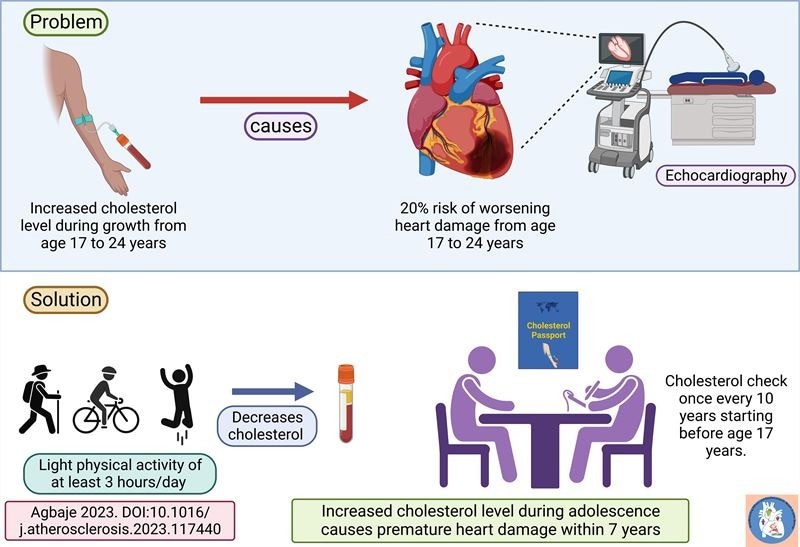Heart disease is the number one killer disease in the world. Elevated cholesterol and dyslipidemia in children and adolescents increase the risk of premature death in the mid-forties and subclinical atherosclerosis in the mid-twenties. Among teenagers without genetic conditions for elevated cholesterol levels, the prevalence of elevated cholesterol and dyslipidemia is 20% which increased to 25% by mid-twenties.
 Increased cholesterol levels in adolescence potentially cause heart damage in adolescence and young adulthood, however, light physical activity can significantly reduce cholesterol levels. An adolescent cholesterol passport similar to a vaccination card tracks cholesterol levels during a once-in-10-year visit to a primary health center. Image Credit: Andrew Agbaje.
Increased cholesterol levels in adolescence potentially cause heart damage in adolescence and young adulthood, however, light physical activity can significantly reduce cholesterol levels. An adolescent cholesterol passport similar to a vaccination card tracks cholesterol levels during a once-in-10-year visit to a primary health center. Image Credit: Andrew Agbaje.
The current study used data from the University of Bristol’s Children of the 90’s cohort, also known as the Avon Longitudinal Study of Parents and Children. Altogether 1,595 adolescents, 640 males and 955 females, were included in the analyses. The adolescents were 17 years old at baseline, and they were followed up until the age of 24 years. Cholesterol levels and evidence of heart damage were assessed at baseline and follow-up. Signs of heart structure damage are left ventricular hypertrophy and high relative wall thickness, whereas signs of heart function damage are left ventricular diastolic dysfunction and increased left ventricular filling pressure.
With extensive control for fat mass, muscle mass, insulin, glucose, inflammation, blood pressure, smoking status, sedentary time, physical activity, socio-economic status, and family history of cardiovascular disease, and using adults’ cut points for diagnosing heart damage, it was observed that increased low-density lipoprotein cholesterol, and total cholesterol levels increased the risk of premature heart damage by 18–20%. Whereas increased triglycerides doubled and tripled the risk of early structural and functional heart damage during the seven-year follow-up.
The findings revealed that both males and females were affected alike, and that being normal weight and having normal blood pressure did not protect the heart from the adverse consequence of elevated cholesterol. It was discovered that while increased cholesterol contributed 30% to the direct damage of the heart, both increased fat mass and blood pressure indirectly contributed 40% to heart damage. The remaining 30% could be explained by genetics and sedentary time.
Health guidelines generally recommend a cholesterol check by the age of 40 years. However, we are seeing the first evidence of the catastrophic effects of elevated cholesterol levels on the heart more than two decades earlier. Waiting until age 40 years might result in 1 in 5 of the adult population developing preventable heart problems which are very expensive to treat.”
Andrew Agbaje, Award-Winning Physician and Paediatric Clinical Epidemiologist, University of Eastern Finland
“Recently, we discovered that increased sedentary time from childhood contributed to 70% of the increase in cholesterol level before mid-twenties and that engaging in light physical activity can completely reverse elevated cholesterol and dyslipidemia. Taken together, these findings suggest that being sedentary is at the root of health problems, and childhood and adolescent sedentariness is a one-way ticket to cardiovascular diseases and premature death.”
“To reduce the risk of dyslipidemia, experts have proposed universal pediatric lipid screening including the potential adoption of an ‘adolescent cholesterol passport’ to help track the increase in cholesterol levels and initiate a timely preventive treatment in the young population. Our recent studies are now contributing stronger evidence that may facilitate a healthier heart. Therefore, public health experts, pediatricians, parents, and health policymakers should encourage early cholesterol checks, especially in the teenage years,” Agbaje continues.
Dr Agbaje’s research group (urFIT-child) is supported by research grants from Jenny and Antti Wihuri Foundation, the Finnish Cultural Foundation Central Fund, the Finnish Cultural Foundation North Savo Regional Fund, the Orion Research Foundation, the Aarne Koskelo Foundation, the Antti and Tyyne Soininen Foundation, the Paulo Foundation, the Yrjö Jahnsson Foundation, the Paavo Nurmi Foundation, the Finnish Foundation for Cardiovascular Research, Ida Montin Foundation, Kuopio University Foundation, the Foundation for Pediatric Research, and Alfred Kordelin Foundation.
Source:
Journal reference:
Agbaje, A. O. (2023). Increasing lipids with risk of worsening cardiac damage in 1595 adolescents: A 7-year longitudinal and mediation study. Atherosclerosis. doi.org/10.1016/j.atherosclerosis.2023.117440.